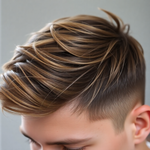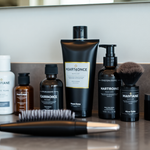
Semi‑Permanent Hair Color: Coordinate, Don't Buy — Build a Sustainable Men's Capsule Wardrobe
18 September 2025
Share
Struggling to look sharp without breaking the bank? Try coordinating, not hoarding.
Struggling to look sharp without breaking the bank? Here’s how to elevate your style with affordable, intentional pieces and a simple grooming tweak. Using semi-permanent hair color alongside a smart, sustainable men's capsule wardrobe cuts decision fatigue, reduces waste, and upgrades your look in a low-commitment way.
Semi-Permanent Hair Color: How this tactic changes the game
Semi-permanent hair color gives you tonal control without the long-term commitment or the damage of bleaching. Instead of buying into seasonal fast-fashion cycles, coordinate your hair tone with a tightly curated wardrobe so every outfit looks deliberate. This post explains the why and the how — from color theory and shopping lists to maintenance and sustainability tips.
Why coordinate, don’t buy
- Less waste. Buying less and selecting pieces that work together means fewer discarded garments.
- Faster mornings. A capsule wardrobe reduces choice overload — outfits are obvious, not stressful.
- Better ROI. Quality items get more wear; a subtle hair color update multiplies the impact of the clothes you already love.
- Low commitment grooming. Semi-permanent hair color fades over weeks, so you can iterate without regret.
Start with an honest wardrobe audit
Pull everything out. Not to be dramatic — you’ll save time and money. Photograph outfits and note what you reach for. Ask yourself:
- Which 10 pieces make me feel confident?
- What colors do I wear most often?
- Which fits flatter my body shape?
From that audit you’ll see a natural palette. Lock in three neutrals (e.g., navy, charcoal, beige) and one to two accents (e.g., rust, olive, cream). This is the foundation of a men's capsule wardrobe.
Semi-permanent hair color: pick the right tone for your palette
Use hair color to harmonize rather than clash. Here are actionable rules:
- Warm palettes: If your clothes lean earth-tone (olive, rust, tan), choose warm browns, chestnut, or subtle copper tones to bring warmth to your face.
- Cool palettes: For navy, grey, or black-heavy wardrobes, a cool ash brown or soft espresso keeps the overall look cohesive.
- Minimal contrast: Avoid extreme contrasts (e.g., very light hair with very dark neutrals) unless that’s a deliberate statement you want to own.
- Skin tone matters: Use warm hair tones with warm undertones, cool tones with cool undertones. If in doubt, test a small strand or consult a stylist.
Step-by-step: build your first capsule and color plan
- Audit & photograph. Create a folder on your phone for outfit reference.
- Choose palette. Pick three neutrals and one to two accents.
- Decide hair direction. Pick a semi-permanent shade to harmonize with your palette — aim for subtlety.
- Buy only gaps. Purchase 4–6 versatile items to complete the set: a jacket, one smart-casual shoe, one knit, one button-down, and one pair of trousers.
- Trial the color. Do a strand test, then apply following the brand instructions. Keep logs of results (photos help).
- Rotate and refine. After 6–8 weeks you’ll see how the color fades; tweak next time based on how it pairs with your clothes.
What a versatile 12-piece capsule looks like
This set covers most men aged 18–45 and balances style and function.
- 1 dark denim jean (slim/straight)
- 1 neutral chinos (olive or khaki)
- 2 high-quality tees (one neutral, one accent)
- 1 Oxford or button-down shirt (white or light blue)
- 1 merino or cotton knit in a neutral
- 1 lightweight jacket (bomber or Harrington)
- 1 unstructured blazer
- 1 pair of casual sneakers or Menll.com EcoSneak for all-day comfort
- 1 pair of boots or derby shoes
- 1 belt and 1 watch
- 1 weather-appropriate outer layer (Menll.com outerwear collection can bridge seasons)
How to shop with sustainability in mind
- Buy better, buy less. Choose durable construction and timeless cuts that won’t date fast.
- Prefer natural or recycled fibers. Merino, organic cotton, hemp, and recycled polyester reduce lifecycle impact.
- Repair and resell. Learn basic repairs and sell or donate what you don’t wear.
- Mindful laundering. Wash less, cold, and line-dry to extend garment life.
Maintenance plan for hair and wardrobe
Maintain both your hair and clothes to get maximum value.
- Hair: Use sulfate-free shampoo, cold water rinses to seal cuticles, and a color-depositing conditioner if you want to prolong tone between applications. Schedule touch-ups every 4–8 weeks depending on fade rate.
- Clothes: Rotate pieces, spot-clean when possible, and follow care labels. Invest in a good iron or steamer — wrinkle-free clothes look intentional.
Costs, ROI, and the environment
Yes, there’s an upfront cost to quality pieces and a box of semi-permanent dye. But when you divide the purchase price by wears, a trusted blazer or shoe becomes cheaper per wear than a fast-fashion tee. Likewise, semi-permanent dye is cheaper and lower damage than salon bleaching, and the ability to experiment reduces impulse purchases.
Safety and best practices for semi-permanent hair color
Semi-permanent formulas are generally gentler because they don't penetrate the hair cortex the way permanent dyes do. Still, patch test for allergies, follow instructions, and avoid mixing formulas. For an authoritative safety overview on hair dye, check WebMD's guidance on hair-dye risks and testing: WebMD hair dye guide.
Seasonal strategies: use color to shift your look
Think of hair tone like a seasonal accent:
- Spring/Summer: Lighter, warmer tones bring a relaxed energy and pair well with lighter fabrics and neutrals like cream and stone.
- Fall/Winter: Deeper, richer tones (warm chestnut, deep espresso) support layers, textured knits, and earth tones.
Styling tricks that amplify the effect
- Lean on texture — a chunky knit adds warmth to a warm hair tone.
- Use small accessories (watch strap, belt) to pick up your accent color for cohesive looks.
- Fit first: Tailoring makes inexpensive pieces look expensive.
Common questions answered
- Will semi-permanent color damage my hair? It’s less damaging than permanent dye. Use conditioning care and avoid overlapping applications to minimize breakage.
- How often should I recolor? Every 4–8 weeks based on fade and desired tone. Color-depositing conditioners can extend time between applications.
- Can I go back to my natural color? Yes — semi-permanent fades gradually, and you can stop coloring when you want to return to natural shade.
Visual suggestions and accessibility
Create imagery that reflects Menll’s aesthetic: clean, minimalist shots of men in neutral layers, close-ups of hair tone in natural light, and flat-lays showing the capsule palette. For accessibility, add alt text describing color and fit (e.g., 'Man wearing olive bomber and navy crew with chestnut hair tone'). Use infographics to map palette to hair tones and a one-page maintenance checklist for download.
Practical checklist you can use now
- Photograph 20 items and identify top 10.
- Choose three neutrals and one-two accents.
- Decide on a semi-permanent hair tone that harmonizes with that palette.
- Buy only what closes gaps: one jacket, one shoe, one knit.
- Set a calendar reminder for color maintenance and clothing rotation.
One small recommendation
For a reliable all-day sneaker that pairs with most capsule palettes, consider the Menll.com EcoSneak; for season bridging, explore the Menll.com outerwear collection to find structured, sustainable layers that match your tones.
Final thoughts: confidence is coordination, not consumption
When you coordinate your hair tone with a tight, durable wardrobe, you simplify decisions and amplify style. Semi-permanent hair color is the perfect low-risk lever to tune your look seasonally and sustainably. Try the plan for 90 days: audit, choose palette, experiment with one semi-permanent shade, and buy only essentials to fill gaps.
Get involved: one quick ask
Which color will you test with your capsule? Drop a comment and share a before-and-after — or browse Menll.com for sustainable outerwear and footwear to complete your set. Tag a mate who needs these style tips on Instagram.
Suggested meta
Meta title: Semi-Permanent Hair Color & Capsule Wardrobe — Menll Guide Meta description: Learn how semi-permanent hair color and a sustainable men's capsule wardrobe simplify style, cut waste, and boost confidence. Step-by-step plan included.
External reference: For hair-dye safety basics and patch testing, see WebMD: https://www.webmd.com/beauty/hair-dye
Vorheriger Beitrag

Semi-Permanent Hair Color Calendar: Schedule Hue Changes to Stretch a Sustainable Men's Capsule Wardrobe
Aktualisiert am 19 September 2025
Nächster Beitrag

Semi‑Permanent Hair Color as a Color‑Coding System: How to Cut Clothing Waste in a Men's Capsule Wardrobe
Aktualisiert am 17 September 2025





